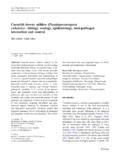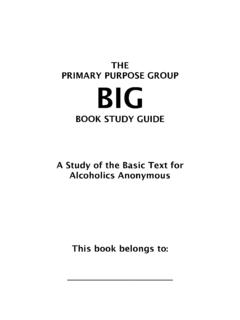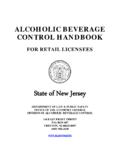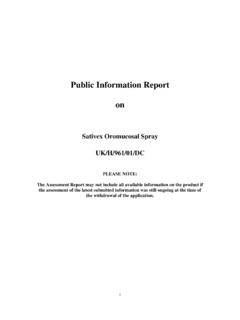Transcription of QUANTITATIVE DETERMINATION OF ETHANOL IN …
1 QUANTITATIVE DETERMINATION OF ETHANOL IN wine BY GAS CHROMATOGRAPHY B. STACKLER and E. N. CHRISTENSEN Presented at the Annual Meeting of the American Society of Enologists, June 21, 1974, San Diego, California. Respectively Research Scientist and Senior Research Scientist, E. & J. Gallo Winery, Modesto, California. Accepted for publication November 5, 1974. ABSTRACT A method is described for specific QUANTITATIVE analysis of ETHANOL in wine by gas chromatography. This method, which uses an internal standard and flame ionization detector, is more accurate and more precise than methods commonly used. Statistical analysis of data from typical winery samples shows that the standard error of estimate for the method is ~/~ (v/v) over the range 7 to 24% (v/v). The estimate of the standard deviation of the chroma- tography for duplicate injections is (v/v). The gas-liquid chromatography method determines ETHANOL separately from the other wine components that interfere in other methods, and without distil- lation or chemical reaction.
2 When large numbers of samples are analyzed, advantages include short analysis time per sample and potential for extensive automation. DETERMINATION of ETHANOL is perhaps the most im- portant routine analysis in a modern winery. Fre- quent, fast, and accurate results are needed to con- trol the quality of the wine from grape to bottle, as well as for state and federal government tax and regulatory purposes. The alcoholic beverage indus- try and various regulatory agencies have devoted much effort in recent years to developing a faster, specific, more accurate, and automated method. Gas-liquid chromatography is one of the most modern analytical techniques, dating from 1952. Even more recently, with the utilization of elec- tronic digital data-processing equipment, gas chro- matography has become increasingly preferred for accurate QUANTITATIVE as well as qualitative analyses of many substances.
3 Traditional ETHANOL analysis methods, involving distillation and/or mass determinations, are known to include small inaccuracies due to the presence of interfering volatile or other components in wine (12). With an appropriately chosen column packing, gas chromatography is inherently specific, separat- ing volatile compounds on the basis of compound- specific partitioning properties between a gas phase and a liquid (or a solid) phase. To evaluate the accuracy, precision, and specificity of the gas-liquid chromatography method described here, it was neces- sary to analyze ETHANOL standards and typical winery samples by a reference method. The reference method used was the micro-dichromate procedure (9). Because of the high accuracy of the GC method, it was also necessary to develop a procedure for estimating the magnitude of the inaccuracy in the dichromate method caused by non- ETHANOL wine vol- atiles.
4 The most significant non- ETHANOL wine com- ponents analyzed as " ETHANOL " by the dichromate method were determined to be methanol and the common fusel oils. wine industry researchers were among the early investigators of QUANTITATIVE gas chromatography (GC) techniques, presenting data on ETHANOL anal- ysis in 1961 (3). A 1961 industry paper included data on a relatively sophisticated GC ETHANOL analysis method utilizing an internal standard and electronic integrator for peak quantitation (8). A variety of GC methods for the analysis of ETHANOL are described in a recent review article by Jain and Cravey (6). Recent papers by Martin and Tenenbaum (7), Solon et al (10), and Goodman and Dorion (5) describe gas-solid chromatographic methods using the newer porous polymer column packings. Despite the ex- tensive research on GC ETHANOL analysis in the past 15 years, no published method has been refined to the high accuracy and precision of the method de- scribed here.
5 A nonlinearity in GC detector response to ETHANOL has been the main obstacle to high ac- curacy in previous work. Additional inaccuracies can be introduced into a GC method by inappropri- Amer. J. Enol. Viticult., Vol. 25, No. 4, 1974 202 203--DETERMINING ETHANOL IN wine ate selection of column packing and internal stand- ard. Several combinations of column packing and internal standard were tested and rejected before the configuration described here was chosen. The method described, utilizing an internal standard, flame ionization detector, and electronic digital in- tegrator, has achieved better results with gas-liquid chromatography than with gas-solid chromatogra- phy. MATERIALS AND METHODS ETHANOL standards: Five ETHANOL standards were prepared by diluting 200-proof ETHANOL (Rossville Gold Shield) with distilled water to cover the range 6 to 20% (v/v) ETHANOL .
6 Pure ETHANOL and distilled water were chosen to minimize the possibility of non- ETHANOL components interfering in DETERMINATION of the ETHANOL content of the standards. Winery samples: One hundred typical winery alcohol-analysis samples were selected for GC anal- ysis. These samples included wine in all stages of production from fermentation through bottling. The ETHANOL content of these 100 samples ranged from 7 to 24% v/v (mean ) and included 36 sam- ples in the range of 14 to 24 %. Dichromate analysis: The standards and wine samples were analyzed repeatedly for ETHANOL con- tent by the micro-dichromate method to obtain an accurate (average) reference analysis for each sample. All samples were analyzed at 20 C and stored at 4 o C. DETERMINATION of interfering substances: Model solutions containing one non- ETHANOL wine volatile in distilled water or in a water- ETHANOL solvent of known ETHANOL concentration were analyzed for " ETHANOL " by the micro-dichromate method.
7 Each model solution contained one non- ETHANOL volatile in a concentration between and 5% (v/v) in the case of methanol, n-propanol, sec-butanol, iso- butanol, isoamyl alcohol, acetaldehyde, ethyl acetate, 2-butanone, or glycerin. The 2,3-butanediol model solutions ranged from 10 to 15% v/v). Potassium sorbate and potassium metabisulfite model solutions were saturated. DETERMINATION of methanol, fusel oils: Methanol, n-propanol, n-butanol, sec-butanol, isobutanol, and isoamyl alcohol were determined in the 100 winery samples by a GC method. For sample preparation, ml of each sample plus ml of 190-proof ETHANOL was steam-distilled, and ml was col- lected. To ml of the distillate, ml of 3-pen- tanol was added as an internal standard. The chroma- tograph consisted of an Aerograph Hi-Fi GC with flame ionization detector, and a 6-ft. X 1/8-inch stainless-steel column packed with 15% Hercoflex 600 on 80/100-mesh Aeropak 30.
8 Column and de- rector temperatures were 61 C, with an injector temperature of 170 C. Helium carrier flow was 30 cc/minute. Attentuation was 16 on the 10 range. Sample size injected was 2 ~1, and peak area counts were printed out on paper tape by a Varian 480 digital integrator. Standardization and calculations were similar to those in the GC ETHANOL method. Internal standard and diluent: The internal stand- ard was reagent grade n-butanol (Matheson Cole- man & Bell Chromatoquality). A 15-liter "diluent- internal standard solution was prepared by diluting n-butanol to (v/v) with distilled water. The diluent solution was stoppered and stored at 20 C. Sample preparation: With a York 2111 automatic diluter, ml of wine (or ETHANOL standard) was diluted to ml with the internal standard-diluent solution. The sample was diluted directly into a 30-ml serum vial and was immediately ready for injection into the GC.
9 Chromatography: A Varian 1400 GC with a flame ionization detector was used. A 6-ft. X 1/~-inch cop- per column packed with 3 % Carbowax 600 on 40/60- mesh Chromosorb T was used. (A 21uidized drying technique was used to prepare the packing.) Column temperature was 80 C, with injector and detector temperatures of 120 and 125 C, respectively. Heli- um carrier flow was 110 cc/minute. Electrometer attenuation was 1 on the 10 -~; range. Sample size injected was t~l. Integration: Peak areas and retention times were calculated and printed out in digital form on paper tape automatically by a Varian 480 electronic inte- grator. Integrator settings included slope sensitivity of 30 seconds ( ) ~v/sec), slope filtering of 10 seconds ( Hz), baseline shift of 50 ~v, and digital baseline correction of 9 ( ~v/sec). Standardization: The five ETHANOL standards were used to standardize the GC method as follows.
10 Each of the five standards was diluted several times. The dilutions for one standard were each injected, and a "response factor" for each dilution was calculated by dividing the ETHANOL peak area counts by the n- butanol (internal standard) peak area counts. For the given standard, an average response factor for the dilutions of that standard was calculated. The dilution that produced the response factor closest to the average was retained for standardization pur- poses, and the other dilutions for that standard were discarded. This selection of an "average dilution" was carried out for each standard. The five average dilutions (corresponding to the five standards) were each injected once for the initial standardization of the GC system, and each injected once on subse- quent days of the experiment. This set of five average dilutions of the standards was handled carefully to avoid evaporation and contamination, and stored at 4 C.






